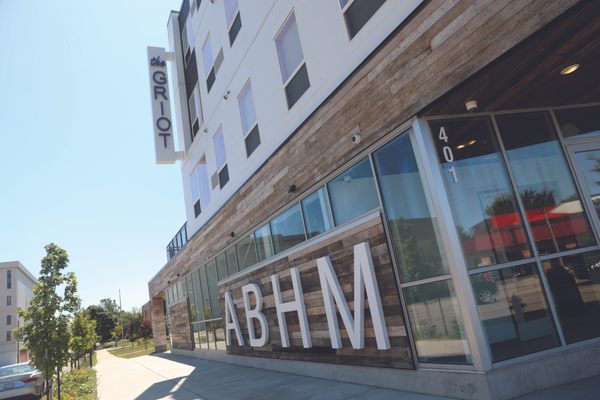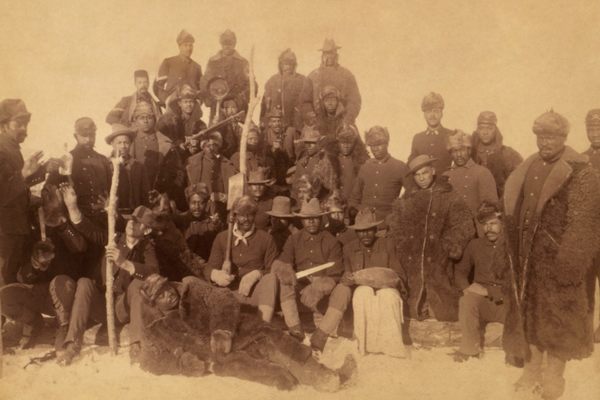The Racist Contradiction at the Heart of the Famous ‘Freedom Train’
A new Rosenbach Museum exhibit highlights the irony of riding the traveling museum piece in the era of Jim Crow.

The Freedom Train. (Photo: National Archives/Public Domain)
This weekend, Rosenbach Museum and Library’s opened its newest exhibit, Freedom Train 1947-1949: Exhibiting America’s Past to Shape America’s Future—whose subject is another exhibit, specifically, one of the most ambitious traveling exhibitions ever seen in the United States.
Alongside some of the documents and artifacts included in the original Freedom Train, the Rosenbach presents the history of the train itself, its depiction of American history and ideals, and the questions it raised as it promoted freedom across a country that still segregated its population and denied rights on the basis of race.
As Rosenbach Associate Curator Kathy Haas explains in a blog post about the new show, the initial idea for the Freedom Train emerged from the Justice Department in 1946, sponsored by then-Attorney General Thomas Clark, although eventually the nonprofit American Heritage Foundation was established to oversee the project. The Rosenbach Museum’s own co-founders, brothers Philip and Dr. A.S.W. Rosenbach, served on the Document Advisory Committee that helped select items for the exhibit, including the Bay Psalm Book, Common Sense, and Abraham Lincoln’s Baltimore address, all of which can be seen at the Philadelphia museum.
The train’s ambitious touring schedule—visiting over 300 communities in all 48 states over 413 days—was accompanied by an equally ambitious advertising effort. “The train was accompanied by a massive citizenship education campaign organized around the slogan ‘Freedom is Everybody’s Job,’” wrote Haas, “This rededication campaign reached one out of every three Americans by utilizing every venue from newspapers to newsreels to Captain Marvel comics and Popeye cartoons.” A Newsworks article describes a Freedom Train-themed Captain Marvel comic included in the Rosenbach exhibit, which features the villainous Dr. Sivana attempting to stop the signing of the Declaration of Independence (he failed, of course).
The Freedom Train even had its own theme song, composed by Irving Berlin and performed by Bing Crosby and the Andrews Sisters.
While the Freedom Train generally received enthusiastic press coverage—The Lincoln Highway National Museum and Archives provides numerous examples of contemporary articles and editorial cartoons extolling the train as a symbol of democratic ideals—civil rights activists of the era were quick to point out the irony of a “Freedom Train” traveling through a country that denied its citizens’ rights due to the color of their skin. Most cutting was Langston Hughes’ poem “Freedom Train,” famously read by actor and activist Paul Robeson. The poem includes lines such as,
I hope there ain’t no Jim Crow on the Freedom Train,
No back door entrance to the Freedom Train,
No sign FOR COLORED on the Freedom Train,
No WHITE FOLKS ONLY on the Freedom Train.
Hughes’ and others’ commentary ultimately led to the exhibit adopting a policy that required each city on the tour to allow desegregated visitation. The cities of Birmingham, Alabama, and Memphis, Tennessee, refused to allow desegregated viewings, and their tour stops were cancelled as a result. In acknowledgment of the Freedom Train’s significance in the battle against segregation, an early manuscript of Hughes’ poem is included in the Rosenbach exhibit.

A desegregated line to view the Freedom Train exhibit in Pine Bluff, Arkansas. (Photo: National Archives via Little (1993), American Studies journal/Public Domain)
By looking at both the contents of the original Freedom Train exhibit and the circumstances surrounding it—particularly the contradiction of a patriotic celebration of “freedom” in the era of Jim Crow—the new Rosenbach exhibit provides a unique look at how previous generations of Americans understood our own history and struggled to fulfill our own ideals. It runs through November 1st, 2016.
































Follow us on Twitter to get the latest on the world's hidden wonders.
Like us on Facebook to get the latest on the world's hidden wonders.
Follow us on Twitter Like us on Facebook